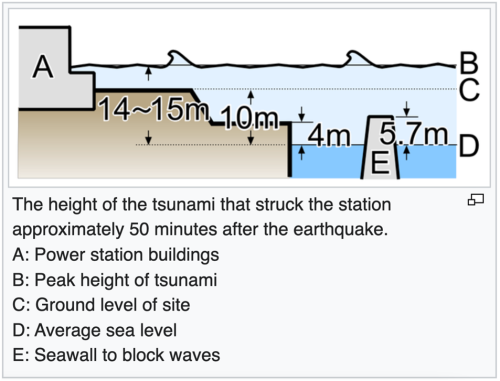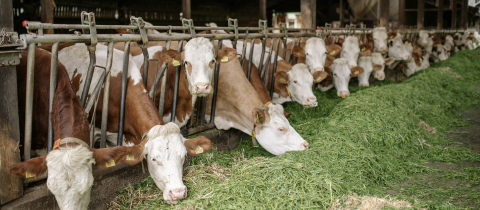A magnitude 9.1 earthquake occurred just off the northeast coast of Japan on March 11th, 2011, at 14:46 local time. The Fukushima Daiichi Nuclear Power Plant, like all nuclear power plants in Japan, features several safety mechanisms meant to mitigate damage to its reactors in such an event. It was built on top of solid bedrock to increase its stability, and all of its reactors featured systems that would automatically shut down—or SCRAM—the fission reactions in response to an earthquake. Luckily, only reactors 1, 2 and 3, out of six total, were in operation on that day and were successfully SCRAMed.
Even with fission stopped, however, the nuclear fuel rods continued to emit decay heat and required cooling to avoid a catastrophe. With connections to the main electrical grid cut off due to earthquake damage, the plant’s emergency backup diesel-run generators kicked in to power the cooling pumps.

Image Source: https://en.wikipedia.org/wiki/Fukushima_nuclear_disaster#/media/File:Fuk...(Tsunami_height).png
Almost exactly one hour after the earthquake, the resulting tsunami struck Fukushima Daiichi with waves 14 metres (46 feet) high. All but one of the diesel generators were disabled by the seawater, and by 19:30, the water level in reactor one had drained below the fuel rod. By the same time, two days later, reactors 1, 2 and 3 had all totally melted down.
In response, over the subsequent days, over 150 000 people were relocated from areas within 40 km of Fukushima Daiichi. Farmers were ordered to facilitate euthanasia for livestock from within the Fukushima exclusion zone, which was estimated to contain 3400 cows, 31 500 pigs, and 630 000 chickens.
Of those 3400 cows, the government euthanized 1500. CNN reports that roughly 1400 were released by farmers to free roam and potentially survive on their own. They are all thought to have starved to death. Three hundred of the remaining animals are unaccounted for, but some farmers who defiantly refused to cull their animals, nor chose to set them free, can account for 200 of the bovines.
Instead, these ranchers—made up almost entirely of cattle breeders—committed to travelling for hours every day into the potentially dangerous Exclusion Zone to continue to feed and care for what some of them refer to as the “cows of hope”.
Where dairy and meat livestock farmers tend to operate larger scale, higher throughput operations, cattle breeders often have small herds and are more attached to individual animals (some even have names). As one farmer told Miki Toda, “The cows are my family. How do I dare kill them?” These animals were spared simply because it was the right thing to do.
These cows and bulls will likely never be used for meat or have their milk collected for consumption. But that doesn’t mean they’re purposeless. Researchers from several universities, including Iwate University, University of Tokyo, Osaka International University, Tokai University, University of Georgia, Rikkyo University and Kitasato University, see the saved herds as an auspicious opportunity for knowledge acquisition.
The scientific research on how radiation affects large mammals is exceedingly sparse. According to Kenji Okada, an associate professor of veterinary medicine from Iwate University, “large mammals are different to bugs and small birds, the genes affected by radiation exposure can repair more easily that it’s hard to see the effects of radiation ... We really need to know what levels of radiation have a dangerous effect on large mammals and what levels don’t.”
By studying the cattle exposed to radioactive fallout after the Fukushima Daiichi nuclear disaster, we stand not only to gain retrospective insights into the true effects of radiation on large bovine mammals but to be better prepared if such an event happens again.
The euthanasia of tens of thousands of farm animals represents a massive animal welfare challenge and has a drastic impact on the livelihoods of many. Not only farmers but workers from regulatory agencies, veterinary practices, slaughterhouses, processing plants, feed supply factories, exporters, and anyone else involved in any step of the agricultural process. Nonetheless, it is, of course, warranted if necessary for the safety of consumers of animal products. But was it necessary?
Research on the Fukushima Exclusion Zone herds has been ongoing for nearly a decade now, and while it will take more time to fully see the effects of chronic low-dose radiation exposure, scientists have published preliminary findings and are starting to see trends.
So far, the bovines have not shown any increased rates of cancer. The only abnormal health indicators are white spots that some have developed on their hides. A study of Japanese Black cattle residing on a farm 12 km to the west-northwest of the Fukushima Daiichi nuclear power plant in one of the areas the Japanese government has deemed the “difficult-to-return zone” found no significant increases in DNA damage in the cows. A different study found that horses and cattle fed with radiocesium-contaminated feed showed high radiocesium levels in their meat and milk. However, they found that after just eight weeks of “clean feeding” (feeding with non-contaminated food), “no detectable level of radiocesium was noted in the products (meat or milk) of herbivores that received radiocesium-contaminated feed, followed by non-contaminated feed.”
Much like Chornobyl (the Ukrainian spelling) has become a sanctuary for wild animals despite the residual radioactivity, signs are pointing to a natural “rewilding” of the Fukushima Exclusion Zone. With humans, cars and domestic animals gone, wildlife is able to move into empty urban and suburban environments and thrive. A trail cam study of wild animals around the Exclusion Zone has uncovered “no evidence of population-level impacts in mid- to large-sized mammals or [landfowl] birds.” Wild boars are abundant in the Fukushima region and present another good representative mammal to research. A study of 307 wild boars found no elevation in genetic mutation rates and that a certain amount of boar meat could even be safely consumed by humans.
Although nuclear radiation is a frightening threat, in part due to its invisible nature, evidence seems to be pointing to minimal, if any, health effects for animals exposed to the amount released by the Fukushima Daiichi disaster.
According to a study from the University of Bristol, it’s likely that the situation would be the same for humans had they not been evacuated/relocated. Due to the relatively low-dose nature of the event, the stigma and sometimes severe mental distress experienced by those displaced, as well as losses of life associated directly with relocation and indirectly via increases in alcohol-use disorders and suicide rates, the authors conclude that “relocation was unjustified for the 160,000 people relocated after Fukushima.”







